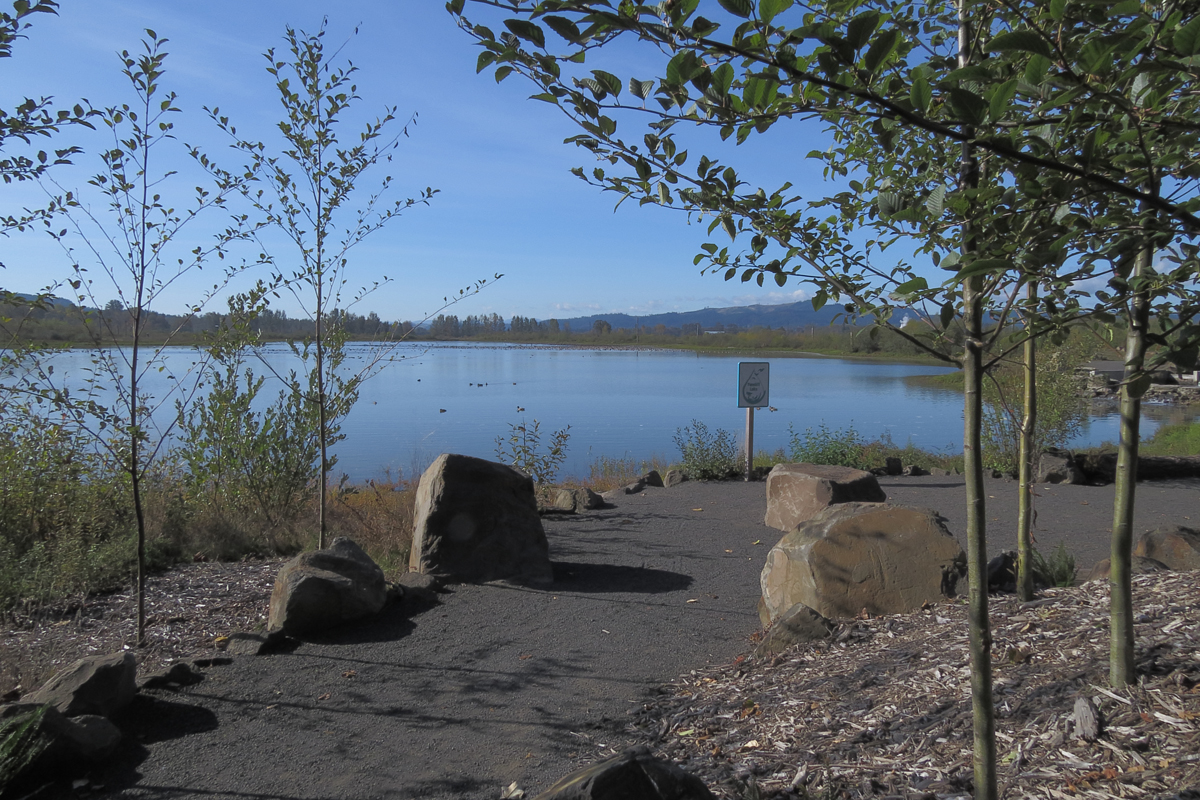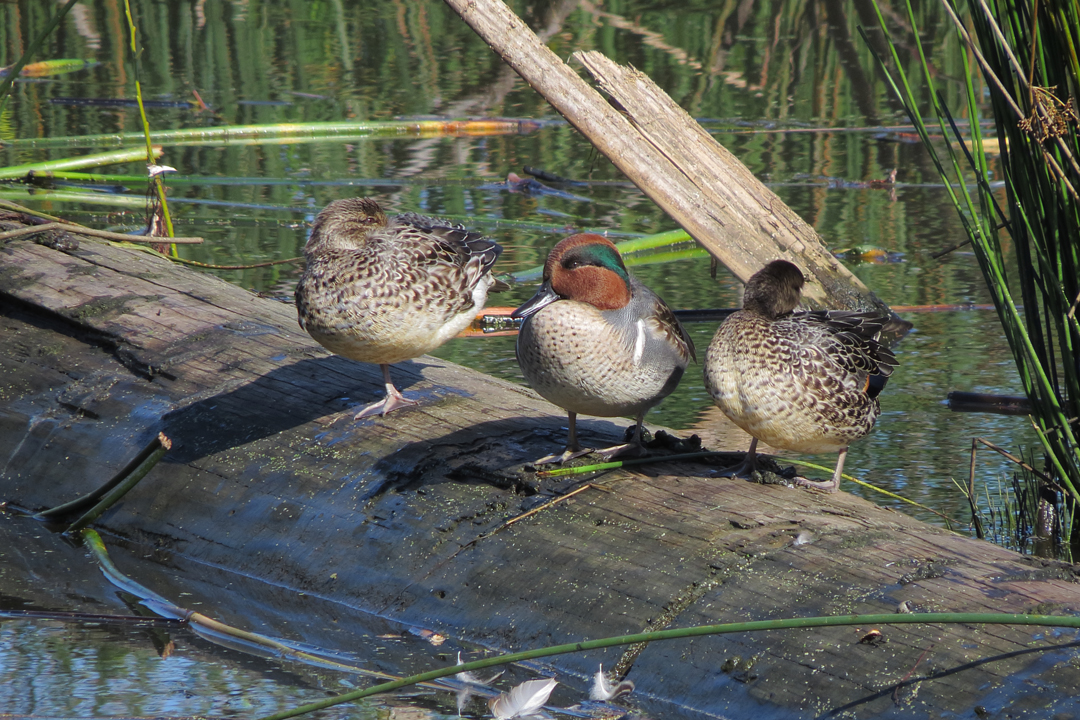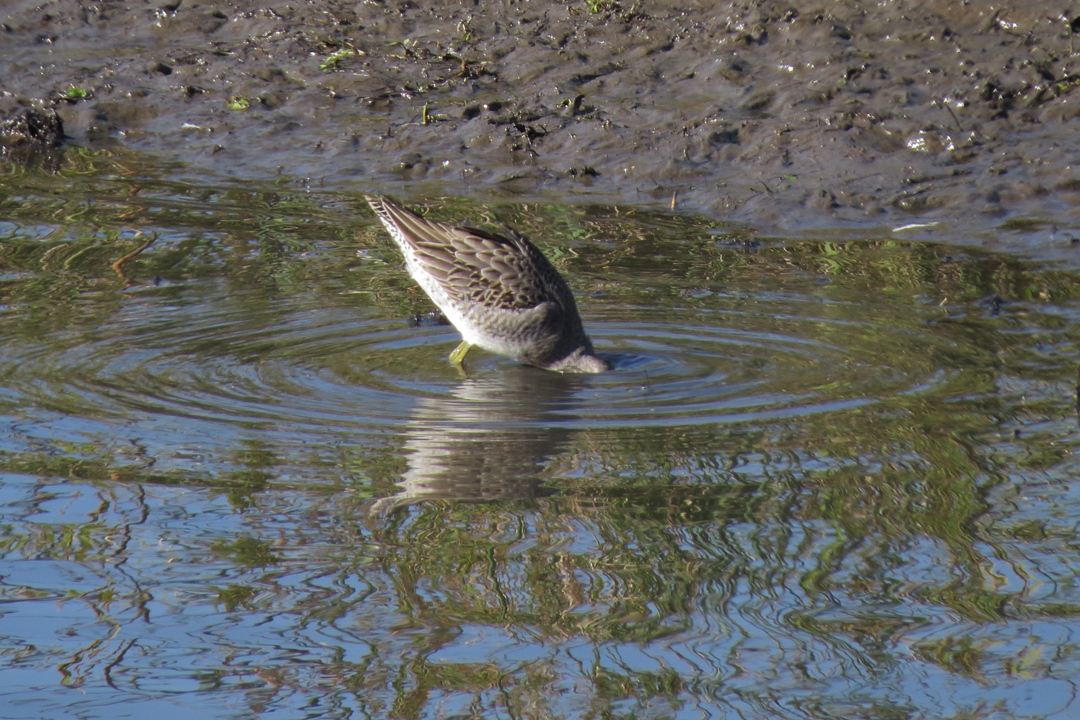





Happy Spring







Happy Spring

Waterfowl numbers have been increasing in the Willamette Valley as the rains have begun. This male Northern Shoveler is still in his drab summer plumage.

This Emperor Goose is currently a local celebrity in the Beaverton area, hanging out with the local ducks and Cackling Geese.

This Gadwall was hanging out at Koll Center Wetlands. A brick building at the edge of the pond creates those brown reflections in the water, which complement the colors on this duck.

American Coot having a snack

Green-winged Teal at Fernhill Wetlands

Common Merganser at Fernhill
Numbers of ducks and geese should continue to increase into November.
Happy Autumn.
 Waterfowl seem to dominate the birding scene in the Willamette Valley in winter. Year-round residents, like this Pied-billed Grebe, are joined by a host of winter migrants.
Waterfowl seem to dominate the birding scene in the Willamette Valley in winter. Year-round residents, like this Pied-billed Grebe, are joined by a host of winter migrants.
 My camera hates white birds, but managed to capture this Common Merganser pretty well.
My camera hates white birds, but managed to capture this Common Merganser pretty well.
 I usually gloss over Mallards, but they are a pretty duck.
I usually gloss over Mallards, but they are a pretty duck.
 Eurasian Wigeon have been hard to come by the past couple of winters, so it was nice to see this pretty boy at Dawson Creek.
Eurasian Wigeon have been hard to come by the past couple of winters, so it was nice to see this pretty boy at Dawson Creek. American Wigeon remain common on grassy lawns and ponds.
American Wigeon remain common on grassy lawns and ponds.
 Green-winged Teal, also at Dawson Creek.
Green-winged Teal, also at Dawson Creek.
There are other birds around this time of year, like sparrows and raptors. But while it is nice to see that Merlin fly overhead and the flocks of Golden-crowned Sparrows deep in the brush piles, sometimes it is good to take the time to study and appreciate the waterfowl that sit out in the open in the daylight.
Happy Winter
 The rainy season has been slow to arrive this year, so we have had strings of sunny autumn days. While the dry conditions are preventing many of the seasonal wetlands from filling, the clear skies do make for some pleasant birding. Here are a few shots from Fernhill Wetlands.
The rainy season has been slow to arrive this year, so we have had strings of sunny autumn days. While the dry conditions are preventing many of the seasonal wetlands from filling, the clear skies do make for some pleasant birding. Here are a few shots from Fernhill Wetlands.
 This Mourning Dove was blending in nicely with the gravel on one of the wastewater filtering beds.
This Mourning Dove was blending in nicely with the gravel on one of the wastewater filtering beds.
 The Killdeer’s pattern provides good camouflage on a rocky background, but doesn’t do as well in dead grass.
The Killdeer’s pattern provides good camouflage on a rocky background, but doesn’t do as well in dead grass.
 The Green-winged Teal are starting to get some nice color.
The Green-winged Teal are starting to get some nice color.
 The Cackling Geese are back in good numbers. There is currently an outbreak of aspergillus, a fungal infection that causes respiratory distress and pneumonia, that has killed dozens of birds at this site.
The Cackling Geese are back in good numbers. There is currently an outbreak of aspergillus, a fungal infection that causes respiratory distress and pneumonia, that has killed dozens of birds at this site.
 The only gulls on this visit were these three Bonaparte’s Gulls, swimming with a Northern Pintail and a Green-winged Teal.
The only gulls on this visit were these three Bonaparte’s Gulls, swimming with a Northern Pintail and a Green-winged Teal.
 Most of the migrant shorebirds are long gone, but there are still some Long-billed Dowitchers around. Note the pattern on the tail showing wider black bars and narrow white bars. This pattern would be reversed on a Short-billed Dowitcher.
Most of the migrant shorebirds are long gone, but there are still some Long-billed Dowitchers around. Note the pattern on the tail showing wider black bars and narrow white bars. This pattern would be reversed on a Short-billed Dowitcher.
Happy Autumn
Spring migration hasn’t really revved up yet, but a recent warm sunny day drew me out to Jackson Bottom Wetlands. I was as interested in herping as I was birding, and some cooperative herps easily filled the void created by relatively low bird numbers.
 This Pacific Chorus Frog (also known as Pacific Tree Frog) was a neat find. I hear this species most of the year, but I seldom get a good look at one.
This Pacific Chorus Frog (also known as Pacific Tree Frog) was a neat find. I hear this species most of the year, but I seldom get a good look at one.
 I normally leave herps that I find in situ, but I couldn’t resist picking up this little Northwestern Garter. The problem with combining birding and herping is that after an encounter like this, your hand smells like garter snake musk. So every time you raise your binocular to your face you get a nose full of snake skank.
I normally leave herps that I find in situ, but I couldn’t resist picking up this little Northwestern Garter. The problem with combining birding and herping is that after an encounter like this, your hand smells like garter snake musk. So every time you raise your binocular to your face you get a nose full of snake skank.
 Here is a much larger Northwestern Garter.
Here is a much larger Northwestern Garter.
 This Red-spotted Garter (a subspecies of Common Garter) was exploring a Red-flowering Currant. I don’t know what he was looking for, but he explored the whole bush before climbing back down.
This Red-spotted Garter (a subspecies of Common Garter) was exploring a Red-flowering Currant. I don’t know what he was looking for, but he explored the whole bush before climbing back down.


 Here is another Red-spotted Garter drinking at a water feature. This individual was at least three feet long.
Here is another Red-spotted Garter drinking at a water feature. This individual was at least three feet long.

I did actually see a few birds on this trip, although they were not nearly as photogenic.
 There are still flocks of Golden-crowned Sparrows around. I would expect them to head north pretty soon.
There are still flocks of Golden-crowned Sparrows around. I would expect them to head north pretty soon.
 Green-winged Teal making friends
Green-winged Teal making friends
I know it is technically not spring yet, but the waterfowl are all either on the move or looking to pair up, so close enough.
 A flock of 12 Greater White-fronted Geese stopped by Force Lake in north Portland. This species migrates through the Willamette Valley in great numbers, but are usually just flyovers.
A flock of 12 Greater White-fronted Geese stopped by Force Lake in north Portland. This species migrates through the Willamette Valley in great numbers, but are usually just flyovers.
 A Greater White-fronted Goose showing off her speckled belly
A Greater White-fronted Goose showing off her speckled belly
 This Greater Scaup was also at Force Lake. Greater Scaup are more often found on larger bodies of water, like the nearby Columbia River.
This Greater Scaup was also at Force Lake. Greater Scaup are more often found on larger bodies of water, like the nearby Columbia River.
 The Canvasbacks on Force Lake were apparently mucking around on the bottom of the lake and came up with very muddy faces.
The Canvasbacks on Force Lake were apparently mucking around on the bottom of the lake and came up with very muddy faces.

 This Gadwall at Commonwealth Lake was showing off for a nearby female.
This Gadwall at Commonwealth Lake was showing off for a nearby female.
 Green-winged Teal have started to move out of the area. This lone male was at Commonwealth Lake.
Green-winged Teal have started to move out of the area. This lone male was at Commonwealth Lake.
 Double-crested Cormorants are just starting to get some brighter colors on their facial skin and eyes.
Double-crested Cormorants are just starting to get some brighter colors on their facial skin and eyes.
Migration should start to really pick up in the next couple of weeks. Happy Vernal Equinox.

This Eurasian Teal was hanging out a Jackson Bottom Wetlands. In the United States, Eurasian Teal (Anas crecca crecca) is considered a subspecies of Green-winged Teal (Anas crecca carolinensis), but in Europe, they are considered separate species.

Males are pretty easy to differentiate. Eurasian Teal has white horizontal bars along the back and pale edges on the facial markings, while Green-winged Teal has vertical bars near the shoulder and lacks the pale borders on the face. Females are much more similar to each other. Eurasians average paler on the face with more white in the wing, but the two are not readily distinguished in the field.
Personally, I like to consider them separate species, but my motivation is based on my desire to list two species, rather than any scientific evidence.
February birding is famously slow around much of Oregon, but, as I like to remind myself, there is always something to see.

This male Redhead has been spending the winter at Commonwealth Lake Park in Beaverton. It is not often that I get a really close view of these lovely ducks.

This preening Black Turnstone showed off his flashy backside at the Seaside Cove.

I have made four trips to Fort Stevens State Park since early December to try to see some of the many White-winged Crossbills that have been spending the winter there. They have eluded me every time. I think I have seen more Elk than I have birds at Fort Stevens this winter.

The bumper crop of cones on the Sitka Spruces is what has attracted the crossbills. There is a lot of food available and the finches keep moving all the time, so our paths have not crossed. It is kind of like pelagic birding. You are moving around the open ocean in a little boat, looking for birds that are also moving.

I went out to Rentenaar Road on Sauvie Island to chum for sparrows. Conditions were dark and damp, but the head of this White-crowned Sparrow shone from the depths of the brush.

The Red-winged Blackbirds are getting fired up for spring. This guy was flashing his epaulets but still showed some rusty pattern on his back from his youth.

preening Green-winged Teal, Westmoreland Park

preening Gadwall, Crystal Springs

male Wood Duck, Crystal Springs

The lighting was not great, but it was nice to see this Lincoln’s Sparrow just sitting out in the open for so long. This is a species that I often see, but am seldom able to show to others because the birds tend to hide in thick cover most of the time. I have two Little Brown Birds classes in March. I hope I can find such a cooperative individual on those days.
 Fernhill Wetlands is the place to be in autumn. Even after the extensive wetland renovations that have taken place, resulting in less open water, the Cackling Geese still congregate here by the thousands.
Fernhill Wetlands is the place to be in autumn. Even after the extensive wetland renovations that have taken place, resulting in less open water, the Cackling Geese still congregate here by the thousands.
 This Great Egret was catching the sunshine on the top of a tree.
This Great Egret was catching the sunshine on the top of a tree.
 Northern Pintail. I don’t often see them hanging out on dry ground.
Northern Pintail. I don’t often see them hanging out on dry ground.
 Killdeer and Green-winged Teal
Killdeer and Green-winged Teal
 Greater White-fronted Geese migrate over the Willamette Valley in large numbers, but not many touch down, so it is always nice to see some on the ground.
Greater White-fronted Geese migrate over the Willamette Valley in large numbers, but not many touch down, so it is always nice to see some on the ground.
 Fernhill Lake is about half of its original size, but it is still big enough to attract divers, like this Horned Grebe.
Fernhill Lake is about half of its original size, but it is still big enough to attract divers, like this Horned Grebe.
Waterfowl diversity continues to increase, and winter sparrow flocks should pick us soon. I’m looking forward to watching the show, assuming the Bundys don’t move in.
I took Nala to the dog park next to Vanport Wetlands in hopes of seeing a bird or two between throws of the ball.
 A male Eurasian Wigeon made a brief appearance.
A male Eurasian Wigeon made a brief appearance.
 A pair of Gadwalls swam in the nearby slough.
A pair of Gadwalls swam in the nearby slough. 
 The large flock of gulls that had been hanging out in the area were not around that morning, but a large puddle hosted this Ring-billed Gull along with some Mew Gulls.
The large flock of gulls that had been hanging out in the area were not around that morning, but a large puddle hosted this Ring-billed Gull along with some Mew Gulls. 